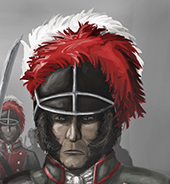Infiniverse is a…
The Infiniverse isn't really based on any real geopolitical situation in our world: redcoats never had to form square against winged hussars, for example. However, the definitive list of cultural analogues would be something like:
Tierra: Habsburg Spain (Hidalgos, a Cortes, a stronger monarchy) and Regency Britain (Fashion, a constitutional tradition, the army and navy) overall. Regionally, Wulfram is more German, Aetoria has stronger Castilian influences. Kentaur is Scotland, with Havenport and the coast being the lowlands, and the hills further north to by the highlands. Cunaris is Norman, while Warburton is inspired more by the southern parts of the former Angevin empire in France.
Takara: The Altrichs is superficially Prussian in a lot of ways, but its political culture is a very fine mix of Imperial Japan, and the modern United States, this includes both its emphasis on personal honour, as well as its very strong democratic tradition, emphasis on equality of opportunity, and (comparatively) very permissive social mores. It also carries into a heavily factionalised legislature led by (usually noble) political dynasties, and a very bellicose foreign policy which is heavily supported by an immense foreign intelligence apparatus which has a reputation for being capable of damn near anything, thanks to its occasional kicking-over of a foreign government once every so often.
Takara's army is very Prussian, its navy is very American, but the way they are organised together is very Japanese, with both services using the same rank structure, being theoretically integrated, and hating each others' guts.
Kian: The Kian combine the fashion and political philosophies of Bourbon France with the social mores and actual political structure of Imperial China (especially the Song and Ming dynasties), with a version of the "Mandate of Heaven" playing a strong role in both their imperial succession and in their view of foreign policy. They're probably the best blended, culturally, down to the language (Mandarin, sounded out with French phonetic rules), and the titles (conveniently, Imperial Chinese noble titles are usually translated into their French equivalents).
Likewise, their military doctrine magnifies the things which Bourbon France and the Ming/Qing had in common: love of artillery, heavily decentralised recruitment, a structure built around a cadre of "Guards" units (be they the Gardes Francaises, or the Army of Forbidden Banners), and with the main strength which seems to be the main emphasis in both the fear of old France, and modern China: the levee en masse.
Note that just as Japan and China share Han influences, and France/Germany both possess common roots within the empire of Charlemagne, both Kian and Takara share cultural roots as well.
Antar is an Eastern European mix: its government is very heavily based on the Seym of the Polish-Lithuanian Commonwealth. Likewise, its strong, self-serving and arrogant nobility is based both on the situation right before the First Partition of Poland, among other things. That being said, the Calligian continent itself also has regional cultural influences: the south (cities whose names end with "gia") are based more on the Baltic regions, the centre (cities whose names end with "birit") represent Antar's imperial legacy (Greek -> Byzantine -> Polish), while the north (cities whose names end with "vil") are more Russian.
On that note, Khorobirit is actually an outlier, as it lies in the North, but the city itself was an outpost of Oberlinder culture, having been originally gifted to one of Saint Stanislaus' retainers.
Incidentally, the "western" traditional rite of Saints-worship has hints of the Slavic Orthodox churches, and the "eastern" rite of Ascensionism is more Roman Catholic in organisation and mindset.
Mhidi'yos is another continent with strong regional distinctions. The mediterranean coastal areas are heavily inspired by Moorish Spain in the North, and Mughal India in the south. The inland is more Persian around the river basins, with analogues of more arabic cultures in the drier areas. Note that Old Mhidi'yos is the culture most like the old Western Roman Empire, including in language: if a "latin" name (Caius, Marcus, Cassius, Julius, etc) shows up in the Infinite Sea, it's Mhidi'yossi in origin.
